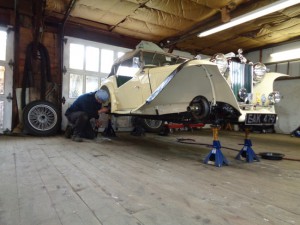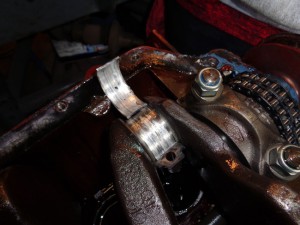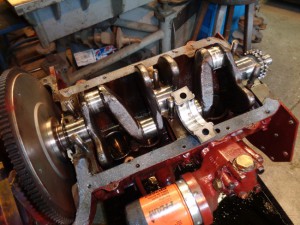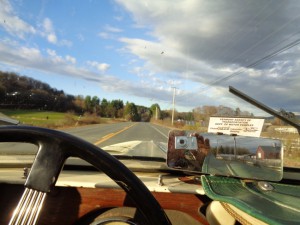A favored MG trivia question is to name a seven letter work with all five vowels in it. The answer is 1949 MG TC in the Sequoia Cream Livery like this one here, on its way back to Virginia soon after a 25 year sojurn in New England. The current property of a retired member of the teaching faculty of Harvard University, it’s headed to the greater Washington D.C. area. Butch is seen here giving it a final once-over before Mike Savage trailers it down there next week.
Tracing an engine failure back to its route cause is always an interesting investigation. The owner of a well presented MG TD MK II (TDC is the proper nomenclature, I believe) contacted us after the engine seized while his wife was driving the car, the failure believed to have been caused by inattention to the oil pressure gauge, what a pity with a relatively low number of hours on it after a rebuild by a well known “T” series specialist in Redding, Connecticut. As you’ll notice, the number one connecting rod bearing and crank journal are pretty well wiped out. The others didn’t fare well, either.
But sometimes things are not the way they seem, and this the mains exonerate the lady. This is great stuff because the main bearings are in fine shape with no evidence of impaired lubrication due to lack of oil. What we have is a fundamental mistake on the part of the installer, failure to ensure the crankshaft was properly cleaned before installation. During the teardown we noticed that while the crankshaft was marked .010″/.010″ indicating main & rod journal size, the less badly damaged con-rod bearings were marked, and in fact measured up, as standard, evidence of a welded-up crankshaft which was not adequately cleaned after repairing.
The damage appears to have been fairly catastrophic to the rod journals, but it’s not the first time we’ve seen it, as a similar failure occurred on the Sequioa Cream TC when we replaced the crankshaft with a new one a number of years ago. At that time replacement VP 252 rod bearings were still available in Vandervell VP2 trimetal material, and they were a good deal more durable. The standard bearing of the day was a white metal VP 383, which was a good engine bearing in a time when one of the tasks of engine bearings was to safely embed small pieces of debris that could damage a crankshaft journal. When a similar post-installation washout occurred with the yellow TC the engine also ground to a halt (no pun intended) because there was no imbedability with VP 2. Unlike this one, however, the crank journals were nitrided and what looked awful polished right off, and a new set of VP 252s installed with no change in operating clearance. Rest assured we never repeated that mistake.







